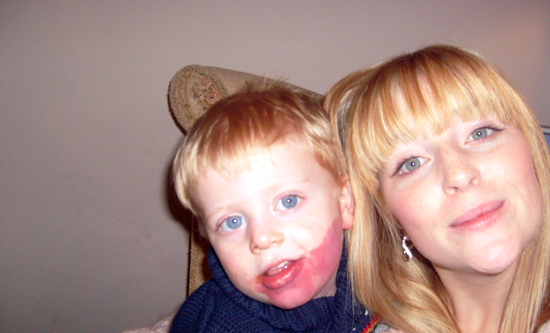
Christopher's story
On 23rd July 2009, I had my fourth child by caesarean
section. The midwife explained that he had a birthmark on his face
but he was "fine." She gave him to my partner who looked first at
our new baby boy, then at me, and said "It's fine, it's quite big
but it looks OK."
When my partner left, I had Christopher on my chest for skin to
skin contact. I held him for five hours. I studied every part of
him. His tiny fingers and toes, his perfectly formed nails, his
tiny little body, his blond hair and of course his tiny little
face. Although his birthmark was a shock, I fell in love with him
the moment I laid eyes on him just as I had with my other
children.
The next day, a cleaner who looked into Christopher's crib said
"Oh a birthmark, that's unsightly" and then carried on with her
cleaning. In that instant, my world crumbled. I was so emotional
and tired after the operation that I didn't have any energy to
react - but inside it broke my heart that someone could be so
cruel.
When the paediatrician came to do the checks before discharging
us, he said that Christopher's birthmark was probably a stork mark
and that given time, it would fade.
Bringing Christopher home was just as exciting as bringing any
of my other babies home. My parents had explained to my other
children that Christopher had a birthmark and looked a little
different. My three-year-old daughter asked why it happened, and my
Mum told her that he'd been kissed by an angel, who had left the
mark. She was then over the moon at the thought of having such a
special brother.
At Christopher's six-week check-up, the GP said that he thought
the birthmark was a port wine stain and not a stork mark. He also
mentioned Sturge-Weber syndrome which we had never heard of. He
referred us to our local hospital as Christopher was also having
feeding problems.
The doctor there dismissed Sturge-Weber syndrome as very
unlikely as the syndrome usually occurs when the birthmark is
higher up on the face and head. He referred us to the Ear, Nose and
Throat (ENT) department at Leicester Royal Infirmary for
Christopher's feeding problems. Christopher was diagnosed as having
laryngomalacia - a floppy larynx - which fortunately was not
related to his birthmark and in time corrected itself.
When we used to go out with Christopher, people stared and
whispered to each other, but none of our friends or family really
said anything. Of course having people staring at your baby is
upsetting and hard to deal with. Nowadays I often forget what
people are staring at.
Since then, Christopher has continued to grow and develop
'normally.' He brings great joy to all our lives, friends and
family included. We don't treat him differently nor expect him to
be treated differently. He isn't disabled or disfigured, he just
happens to have a birthmark.
Christopher is a happy, healthy baby and I want for him what I
want for my other children -for them to grow into well-rounded,
happy individuals who are proud of themselves and everything they
do.
We always said that treatment for removal would always be
Christopher's decision. However I'm concerned that Christopher will
receive a lot of negativity because of his birthmark, and our GP
has referred us to John Radcliffe Hospital in Oxford to find out
about treatment options. I'm not sure if we will have treatment
even if it is available. I'm not sure I want to change my beautiful
boy's face. However I don't think it will do us any harm to find
out.